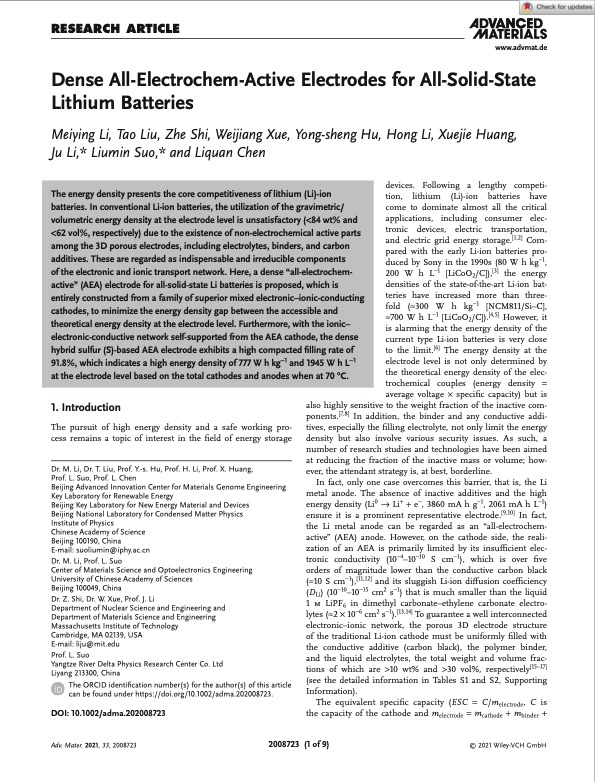
PDF Publication Title:
Text from PDF Page: 001
ReseaRch aRticle Dense All-Electrochem-Active Electrodes for All-Solid-State Lithium Batteries Meiying Li, Tao Liu, Zhe Shi, Weijiang Xue, Yong-sheng Hu, Hong Li, Xuejie Huang, Ju Li,* Liumin Suo,* and Liquan Chen www.advmat.de The energy density presents the core competitiveness of lithium (Li)-ion batteries. In conventional Li-ion batteries, the utilization of the gravimetric/ volumetric energy density at the electrode level is unsatisfactory (<84 wt% and <62 vol%, respectively) due to the existence of non-electrochemical active parts among the 3D porous electrodes, including electrolytes, binders, and carbon additives. These are regarded as indispensable and irreducible components of the electronic and ionic transport network. Here, a dense “all-electrochem- active” (AEA) electrode for all-solid-state Li batteries is proposed, which is entirely constructed from a family of superior mixed electronic–ionic-conducting cathodes, to minimize the energy density gap between the accessible and theoretical energy density at the electrode level. Furthermore, with the ionic– electronic-conductive network self-supported from the AEA cathode, the dense hybrid sulfur (S)-based AEA electrode exhibits a high compacted filling rate of 91.8%, which indicates a high energy density of 777 W h kg−1 and 1945 W h L−1 at the electrode level based on the total cathodes and anodes when at 70 °C. 1. Introduction The pursuit of high energy density and a safe working pro- cess remains a topic of interest in the field of energy storage Dr. M. Li, Dr. T. Liu, Prof. Y.-s. Hu, Prof. H. Li, Prof. X. Huang, Prof. L. Suo, Prof. L. Chen Beijing Advanced Innovation Center for Materials Genome Engineering Key Laboratory for Renewable Energy Beijing Key Laboratory for New Energy Material and Devices Beijing National Laboratory for Condensed Matter Physics Institute of Physics Chinese Academy of Science Beijing 100190, China E-mail: suoliumin@iphy.ac.cn Dr. M. Li, Prof. L. Suo Center of Materials Science and Optoelectronics Engineering University of Chinese Academy of Sciences Beijing 100049, China Dr. Z. Shi, Dr. W. Xue, Prof. J. Li Department of Nuclear Science and Engineering and Department of Materials Science and Engineering Massachusetts Institute of Technology Cambridge, MA 02139, USA E-mail: liju@mit.edu Prof. L. Suo Yangtze River Delta Physics Research Center Co. Ltd Liyang 213300, China The ORCID identification number(s) for the author(s) of this article can be found under https://doi.org/10.1002/adma.202008723. devices. Following a lengthy competi- tion, lithium (Li)-ion batteries have come to dominate almost all the critical applications, including consumer elec- tronic devices, electric transportation, and electric grid energy storage.[1,2] Com- pared with the early Li-ion batteries pro- duced by Sony in the 1990s (80 W h kg−1, 200 W h L−1 [LiCoO2/C]),[3] the energy densities of the state-of-the-art Li-ion bat- teries have increased more than three- fold (≈300 W h kg−1 [NCM811/Si–C], ≈700 W h L−1 [LiCoO2/C]).[4,5] However, it is alarming that the energy density of the current type Li-ion batteries is very close to the limit.[6] The energy density at the electrode level is not only determined by the theoretical energy density of the elec- trochemical couples (energy density = average voltage × specific capacity) but is also highly sensitive to the weight fraction of the inactive com- ponents.[7,8] In addition, the binder and any conductive addi- tives, especially the filling electrolyte, not only limit the energy density but also involve various security issues. As such, a number of research studies and technologies have been aimed at reducing the fraction of the inactive mass or volume; how- ever, the attendant strategy is, at best, borderline. In fact, only one case overcomes this barrier, that is, the Li metal anode. The absence of inactive additives and the high 0+− −1 −1 energy density (Li → Li + e , 3860 mA h g , 2061 mA h L ) ensure it is a prominent representative electrode.[9,10] In fact, the Li metal anode can be regarded as an “all-electrochem- active” (AEA) anode. However, on the cathode side, the reali- zation of an AEA is primarily limited by its insufficient elec- tronic conductivity (10−4–10−10 S cm−1), which is over five orders of magnitude lower than the conductive carbon black (≈10 S cm−1),[11,12] and its sluggish Li-ion diffusion coefficiency (DLi) (10−10–10−15 cm2 s−1) that is much smaller than the liquid 1 m LiPF6 in dimethyl carbonate–ethylene carbonate electro- lytes (≈2 × 10−6 cm2 s−1).[13,14] To guarantee a well interconnected electronic–ionic network, the porous 3D electrode structure of the traditional Li-ion cathode must be uniformly filled with the conductive additive (carbon black), the polymer binder, and the liquid electrolytes, the total weight and volume frac- tions of which are >10 wt% and >30 vol%, respectively[15–17] (see the detailed information in Tables S1 and S2, Supporting Information). The equivalent specific capacity (ESC = C/melectrode, C is the capacity of the cathode and melectrode = mcathode + mbinder + DOI: 10.1002/adma.202008723 Adv. Mater. 2021, 33, 2008723 2008723 (1 of 9) © 2021 Wiley-VCH GmbHPDF Image | Dense All-Electrochem-Active Electrodes for All-Solid-State Lithium Batteries

PDF Search Title:
Dense All-Electrochem-Active Electrodes for All-Solid-State Lithium BatteriesOriginal File Name Searched:
Li21LiuAM.pdfDIY PDF Search: Google It | Yahoo | Bing
Sulfur Deposition on Carbon Nanofibers using Supercritical CO2 Sulfur Deposition on Carbon Nanofibers using Supercritical CO2. Gamma sulfur also known as mother of pearl sulfur and nacreous sulfur... More Info
CO2 Organic Rankine Cycle Experimenter Platform The supercritical CO2 phase change system is both a heat pump and organic rankine cycle which can be used for those purposes and as a supercritical extractor for advanced subcritical and supercritical extraction technology. Uses include producing nanoparticles, precious metal CO2 extraction, lithium battery recycling, and other applications... More Info
| CONTACT TEL: 608-238-6001 Email: greg@infinityturbine.com | RSS | AMP |